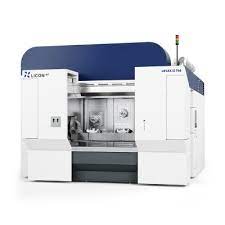Twin Spindle Machining Center
Twin Spindle Machining Center
Due to its rigid design the LiFLEX II 766 performs as twin-spindle, with 500 Nm per spindle and a feed force of 10 000 N. With such a powerful machine, we are now machining two calipers of GLS 600 material in the time of one and save much hall space too.

Haldex, a leading brake system supplier for trucks and truck trailers, has improved productivity significantly. Before finding a better solution with LiCON, the standard machining concept consisted of robust single-spindle machines with four axes. The tomb stone type fixtures required long tools, which lead to chattering while machining the GJS 600 material. With LiCON twin-spindle machining center in 5-axis execution, the challenges are perfectly managed.
Project requirements and conclusions in brief
- Significant capacity increase in existing hall
Twin-spindle machines with much higher productivity per floor space - Simultaneous production with twin-spindle machining
- Reduced complexity with automated direct loading via robot
- Specific project requirements met with flexibility
- Improved performance with shorter tools and five-axis-machine
Significant capacity increase in existing hall
Philip Andersson the Managing Director explains the strategy: "With ten twin-spindle LiCON machines, we increase the caliper production by 40% and we even do not have to add any hall space. We have a standard design of automated robot loaded cells consisting each of five machining centers, robot loading, bin picking of raw parts and an integrated CMM machine. We are glad to have the robust LiCON machines as core part of our strategic capacity increase."
Simultaneous production with twin spindle machining
Due to its rigid design the LiFLEX II 766 performs as twin-spindle, with 500 Nm per spindle and a feed force of 10 000 N. "With such a powerful machine, we are now machining two calipers of GLS 600 material in the time of one and save much hall space too. The LiFLEX machines are made for heavy machining," says Björn Kihlberg, the Production Engineer at Haldex, who has been a driving part of the entire transformation.
Reduce complexity
Per Holmqvist, the Global Manufacturing Engineering Director: "On top of that, we now have a direct loading, which reduces the number of fixture nests to be checked to a minimum. The loading by robot is so fast, that direct loading is the best solution for this application, as the number of fixture nests is limited to the ones in production."
Specific project requirements met with flexibility
LiCON is perfectly sized to build great machines and still listen to the customer. Thorsten Scheid, Global Project Manager Operations at Haldex is impressed: "All our individual requirements have been considered and were realized perfectly."
Improved performance
The design of the caliper requires milling of a feature, which is inaccessible for a standard tool, as it is hidden behind the workpiece itself. To machine the caliper on a four-axis machine, a z-shaped double angle head had to be used, very complex to maintain. Haldex was looking for a more economical solution, which LiCON provided with the five-axis solution. A much more robust 90° angle head is now in use. The high forces during the milling process are supported by the three robust pins built on to the 500 Nm spindles, supporting the angle head. This way, chatter free production is achieved, at high feed rates even with two work pieces at the same time. Fadil Fazlic, the Haldex Cutting Tool Manager praises: "We managed to avoid the z-shaped angle head, as we can position the caliper in the five-axis machine in the best operating position."





